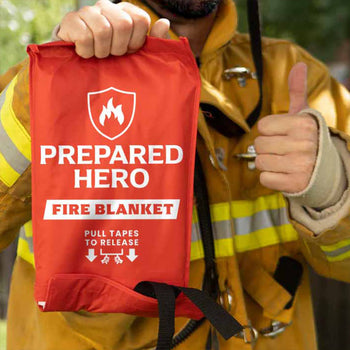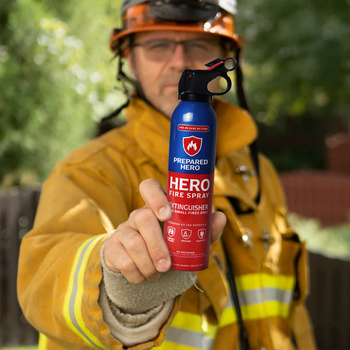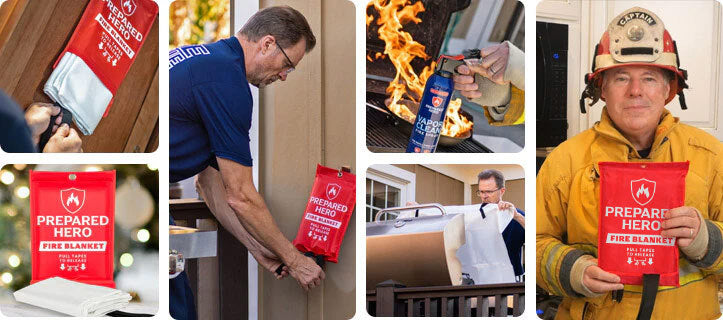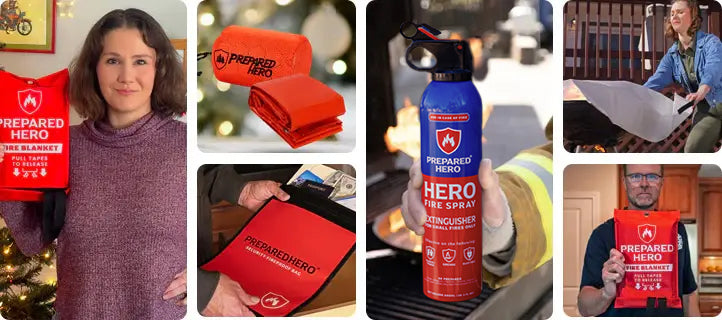Where you put your smoke detectors matters just as much as installing them. Proper placement makes sure they can detect...
A tiny spark can quickly become a full-blown disaster if not handled properly. But exactly how long does it take for a small flame to turn into a major fire?
Time is critical—from the first flicker to when the fire consumes the room. In this article, we’ll break down how fast fire spreads, the stages it goes through, and what to do to protect your loved ones.
What Is Fire?

Fire is fast, hot, and deadly. It's a chemical reaction that happens when fuel (like wood or paper) and oxygen mix together to produce heat and light. This reaction needs three things: oxygen, fuel, and heat. Take away any of those, and the fire stops.
Here’s the thing: fire can spread fast. In less than a minute, a tiny flame can grow into a full-blown blaze. Fire is so dangerous because it doesn’t waste time. It can fill a room with thick black smoke in minutes, and a house can be fully engulfed in flames way faster than you’d expect.
Fire is also hot. The heat alone can be deadly, even before the flames touch you. Temperatures in a burning room can reach 600°F at eye level, which is hot enough to melt your clothes to your skin or burn your lungs if you breathe in the air.
But fire isn’t just about flames. It also makes the surroundings dark. As a fire grows, it fills the air with smoke, which makes it pitch black. If you wake up to a fire, you might not be able to see anything, and you could easily get lost in your own home. That’s why it’s important to stay low to the ground where the air is clearer.
And the most dangerous part? Fire is deadly. Smoke and toxic gases kill more people than the flames. These colorless and odorless gases sneak up on you and often put you to sleep before the fire reaches you. That’s why it’s so important to have smoke alarms, including those that can detect carbon monoxide. When a fire starts, you don’t have much time to react, so knowing what to do makes a huge difference.
Stages of Fire
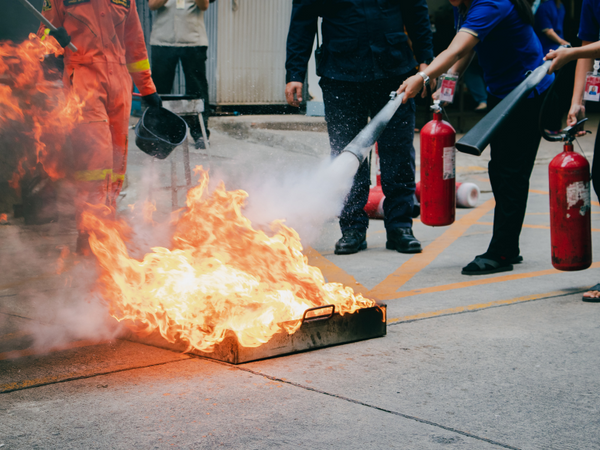
Fire has four stages, according to the National Fire Protection Agency (NFPA): ignition, growth, fully developed, and decay. Each stage presents different dangers, and recognizing them early can prevent a small flame from turning into a disaster. Let’s take a look at each stage below:
Ignition
The ignition stage marks the start of the fire when heat, oxygen, and fuel come together. During this stage, the chemical reaction sparks the flame. This is the earliest and most manageable phase of the fire. At this point, the fire is still small, often just a tiny flame or ember. It could be something as simple as a lit match, a spark from a malfunctioning appliance, or a smoldering piece of paper.
You can control the fire using a fire blanket, fire spray, or fire extinguisher because it’s just starting. However, this stage can quickly become worse if you don’t handle it immediately. Unfortunately, many people don’t recognize a fire at this stage until it starts to spread. The quicker you act, the easier it is to prevent the fire from growing.
Growth
Once the fire has passed the ignition stage, it enters the growth phase. During this stage, the fire starts to spread and grow. It also has access to more fuel, and as it continues to burn, the flames become larger and the heat more intense. The fire then starts to spread to nearby combustible materials, increasing in size rapidly. This stage is dangerous because the fire begins to spread beyond its original source.
For instance, the fire moves from a small pile of clothes or paper to the walls, furniture, and ceiling. At this point, the temperature rises significantly, and the air may become harder to breathe because of more smoke and harmful gases. This stage is particularly dangerous because, as the fire spreads, it can quickly reach a flashover—a rapid, catastrophic event where everything in a room can ignite simultaneously.
A flashover occurs when temperatures reach 932°F (500°C) to 1,100 °F (593°C). This turns the room into an uncontrollable inferno in seconds. This stage requires immediate intervention from professionals. Without quick action, a fire in the growth stage can quickly progress to the fully developed phase.
Fully Developed
A fire that has reached this stage is at its peak size and intensity. This is the most dangerous stage of a fire, where the temperature is at its highest, and the flames are consuming nearly all available fuel. In short, the fire has spread through the entire area and is burning intensely. In a structure fire, this could mean that the entire house or building is engulfed in flames. In a wildfire, it might mean vast areas of land, trees, and vegetation are completely burned.
During this stage, the fire produces thick, black smoke, which reduces visibility and makes it incredibly difficult to navigate or escape. The heat generated in this phase can reach over 2,000°F (1,093°C), which is more than enough to cause severe burns and structural collapse. Fires at this stage consume oxygen rapidly, which makes it difficult to breathe.
Fully developed fires are very difficult to put out and usually require extensive firefighting resources, including large amounts of water and heavy equipment. If the fire isn't contained as soon as possible, it can burn until it runs out of fuel. The longer a fire remains in this stage, the more destructive it becomes.
Decay
Fire enters the decay stage once it has used up most of its fuel, and the flames begin to die down. This stage doesn’t mean the fire is completely out. Rather, it’s in its final, less intense phase. As the fire consumes all the available fuel, the temperature begins to decrease, and the flames become smaller. However, there’s residual heat and potential flare-ups during this phase. In some cases, the fire can smolder for a long time, especially if there are embers or remaining fuel nearby.
This stage is particularly dangerous because it’s easy to assume the danger has passed. Plus, a smoldering fire can reignite under the right conditions, especially if oxygen is introduced (like a gust of wind or air currents).
Backdrafts are another danger in the decay stage. It occurs when oxygen is suddenly introduced to a smoldering fire, causing an explosive burst of flames and heat. Firefighters are especially cautious during this stage and use ventilation techniques to safely control the remaining heat and prevent flare-ups. Although the fire may appear to be dying down, it’s not truly over until the area is completely cooled and all remaining embers are extinguished.
Factors That Influence Fire Growth

The fire triangle, also known as the combustion triangle, refers to the three elements needed to start and sustain fire. The three components are heat, fuel, and oxygen. Let's take a look at each of them in more detail:
1. Heat
Heat ignites, sustains, and enables the fire to spread. A heat source raises the temperature of flammable items to the point of combustion. It also triggers a chemical reaction that releases more heat and energy. As the fire grows, the heat increases. This process dries out nearby fuel, making it easier for the fire to spread. It also heats up the surrounding air, which can cause more materials to reach their ignition point and fuel the fire more.
Cooling down a fire helps put it out. You can do this using a fire blanket, fire spray, or fire extinguisher. Fire sprays and fire extinguishers contain agents that can cool down the fire, while a fire blanket covers the fire to remove oxygen and cool it down. These tools help, especially on grease and electrical fires where water is not an option.
2. Fuel
Fuel refers to anything that can burn and feed a fire. It includes a wide variety of things, like wood, paper, gasoline, vegetable oil, and fabric. Fuels burn at different rates, so the kind of fuel plays a huge role in how easily a fire starts and spreads. For example, materials like paper, dry wood, and fabric ignite quickly, while metals or fire-resistant materials are less likely to catch fire.
Unfortunately, it’s almost impossible to remove fuel from the equation. So, the best way to deal with it is by preventing heat from having access to fuel. This means keeping combustible items away from heat sources, using fire-resistant materials, and storing flammable items safely. For example, storing gasoline away from any heat source reduces the chance of a fire. By minimizing the fuel available, you reduce the chance of a fire starting.
3. Oxygen
Oxygen is also essential for a fire to burn. It reacts with the fuel during combustion. This releases heat and produces gases like carbon dioxide. The atmosphere contains 21% oxygen, which is enough to fuel fires. In fact, most fires can burn with as low as 16% oxygen, so there’s plenty in the environment to keep a fire going. This is why fires can spread quickly in forests.
But we have some good news: oxygen is the easiest element to remove from the fire triangle. One of the simplest ways to do this is by using a fire blanket. A fire blanket works by smothering the fire, cutting off its oxygen supply, and suffocating the flames.
How Long Does It Take for a Small Flame to Turn into a Major Fire?

A small flame can turn into a major fire surprisingly fast. According to the US Department of Homeland Security, a small flame can turn into a major fire within 30 seconds. Fires don’t waste time, and once they start, they can spread quickly.
Several factors influence how fast a small flame can turn into a major fire. The most important ones are fuel, heat, and oxygen—all components of the fire triangle. If there are a lot of flammable and combustible materials around, the fire will find plenty of fuel to spread. The more fuel there is, the faster the fire grows. On top of that, if there’s good air circulation (aka plenty of oxygen), the flames will burn more intensely and spread faster.
For example, the fire might be small at first, but the temperature quickly rises. As the heat builds up, a flashover can occur. This is a critical point where everything in the room that can burn—furniture, paper, clothing, etc.—ignites almost simultaneously. A flashover can happen within a few minutes after the fire has started. When it does, the fire becomes extremely hard to control.
A small flame can also become a fully developed, out-of-control blaze within a few minutes. The heat, fuel, and gases will make the situation worse. In a confined space, the lack of ventilation can make it even more intense. It’s also worth noting that smoke can fill up a room within a few minutes, making it difficult to escape.
In short, a small flame can turn into a major fire in less than 30 seconds, especially if conditions are right. The more fuel, oxygen, and heat present, the faster the fire can spread. That’s why early detection and fire prevention are so crucial. Once a small flame starts, you have to act right away.
How Long It Takes for Fire to Spread: A Timeline

Fires can spread faster than most people realize. Understanding how fast fires spread helps you and your loved ones stay safe. In this section, we’ll break down how quickly a fire can escalate, starting from the first 30 seconds to five minutes.
30 Seconds
Within just 30 seconds of ignition, a small fire can spread. The initial flames will burn nearby materials and fuel the flames further. As the fire burns, it creates heat that causes other nearby items to start releasing flammable gases. These gases will allow the fire to continue to spread. At this point, the fire may still be small, but it’s important to recognize that it’s growing.
Smoke also begins to form within 30 seconds. It can become thick and toxic within moments. The smoke could also contain deadly gases like carbon monoxide and hydrogen cyanide at this point. It will then rise towards the ceiling and start to fill the room. This is dangerous because the heat and smoke reduce visibility and make it hard to breathe.
If you catch a fire at this point, using the correct fire prevention tool helps suppress the flames. Avoid water, especially on grease and electrical fires. If it’s safe, cover the source of the fire with a fire blanket to put out the flames. Remember, the first 30 seconds are the most crucial. If you don’t act quickly, the fire will get out of control.
One Minute
The fire can pick up speed within one minute. The flames can spread to other nearby objects, such as kitchen cabinets, curtains, or even furniture. As the fire continues to grow, it starts generating more heat and raises the temperature of the air around it. The higher the heat, the faster the fire spreads.
At this point, the room could be filled with smoke, which has become thicker and more toxic. Breathing the smoke becomes dangerous because the air temperature can reach 190°F (87.8°C). This is already hot enough to burn your respiratory system, cause injuries, or make you unconscious.
Plus, the fire is now pushing past the source. More flammable materials, such as wooden furniture, curtains, or papers, catch fire. As the fire heats up, the toxic gases it produces start to get more concentrated. Carbon monoxide is dangerous because it’s colorless and odorless.
Two Minutes
The fire can be a serious threat within two minutes. It can grow larger and consume more of the room’s contents. The heat rises, and temperatures near the ceiling are well over 190°F (87.8°C), while the flames can reach up to 500°F (260°C). The plume of hot air and smoke rising from the fire can be felt throughout the room. It can also reach the top of doorways, windows, and vents. The air can be thick with toxic gases like carbon monoxide, hydrogen cyanide, and formaldehyde.
The toxic smoke can also flow into other parts of the house. If the fire is in a kitchen or living room, it’s possible that it has reached other areas of the home by now. Furniture, wood paneling, or other materials will likely burn from the heat radiating from the flames. Survival becomes shorter because your options for escape start to shrink. The heat alone is enough to cause life-threatening burns, and the toxic air can knock you out if you don’t evacuate immediately.
Three Minutes
The fire will likely be out of control in three minutes. The temperature in the room can reach a deadly temperature of 400°F (204°C) or higher. Plus, the fire has likely consumed all easily available fuel at this point. The dense smoke that fills the room has higher concentrations of poisonous chemicals. Aside from burning your respiratory system, these gases can also affect your brain.
At this stage, the fire can spread by two methods: direct flame contact or auto-ignition. Auto-ignition happens when the temperature in the room reaches the ignition point of nearby materials—without direct flame contact. Wooden furniture, clothing, and paper can spontaneously combust if the room has reached temperatures between 346°F (174°C) and 558°F (292°C). If you haven’t evacuated, there’s little time left. The intense heat and toxic air will make it nearly impossible to survive in the room where the fire started, especially if you can’t get out.
Four Minutes
At four minutes, the fire is likely outside the room of origin and spreading quickly through the rest of the house. The flames will be visible from the outside. Plus, the fire has now reached its peak intensity, and temperatures can climb to 1,400°F (760°C) or more. The structure of the home begins to fail under the extreme heat, and key elements like beams, columns, and floors start to weaken. This increases the risk of structural collapse, and anyone inside is in immediate danger.
At this point, escaping from the building is nearly impossible. Stairwells and hallways are filled with thick, hot smoke that makes visibility close to zero. In addition, the heat is intense enough to cause serious burns. Firefighters arriving at the scene will immediately focus on containing the fire to prevent further spread. If you're still inside, your survival depends on escaping immediately.
Five Minutes
The fire is in full force in five minutes. Most of the house is now burned, with flames consuming everything in their path. Newer homes with synthetic materials can experience floor collapses in as fast as five minutes, and the roof may follow soon after. Temperatures inside can reach 1,600°F (871°C), and the heat continues weakening the structure.
At this point, any combustible materials in the house are either already burning or about to. Firefighters have to race against time to control the blaze. The fire is often beyond saving at this stage, and the best action is to stay out and not go back in for any reason.
Conclusion
Understanding how fast fire grows and what to expect during each stage can help you make quick decisions to protect yourself and others. Whether it’s a small grease fire in the kitchen or an accidental spark in the living room, every second counts.
Having the right fire prevention tools ready and working is also important. Fire moves fast, but with the right knowledge, tools, and preparedness, you can stay one step ahead and protect your loved ones.
Do you want reliable, easy-to-use, and affordable tools to put out small fires before they spread? Check out Prepared Hero’s fire prevention tools here, and get up to 51% off on certain items. Stay prepared, hero!


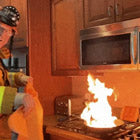 Fire
Fire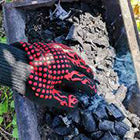 Safety
Safety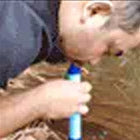 Survival
Survival Protection
Protection New
New
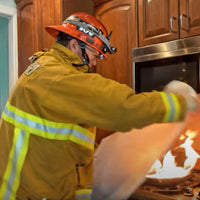 Fire
Fire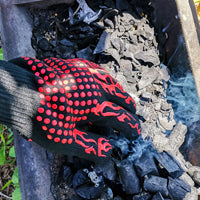 Safety
Safety Survival
Survival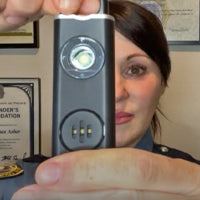 Protection
Protection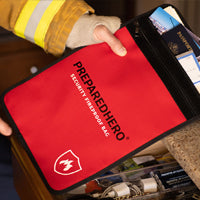 New
New
